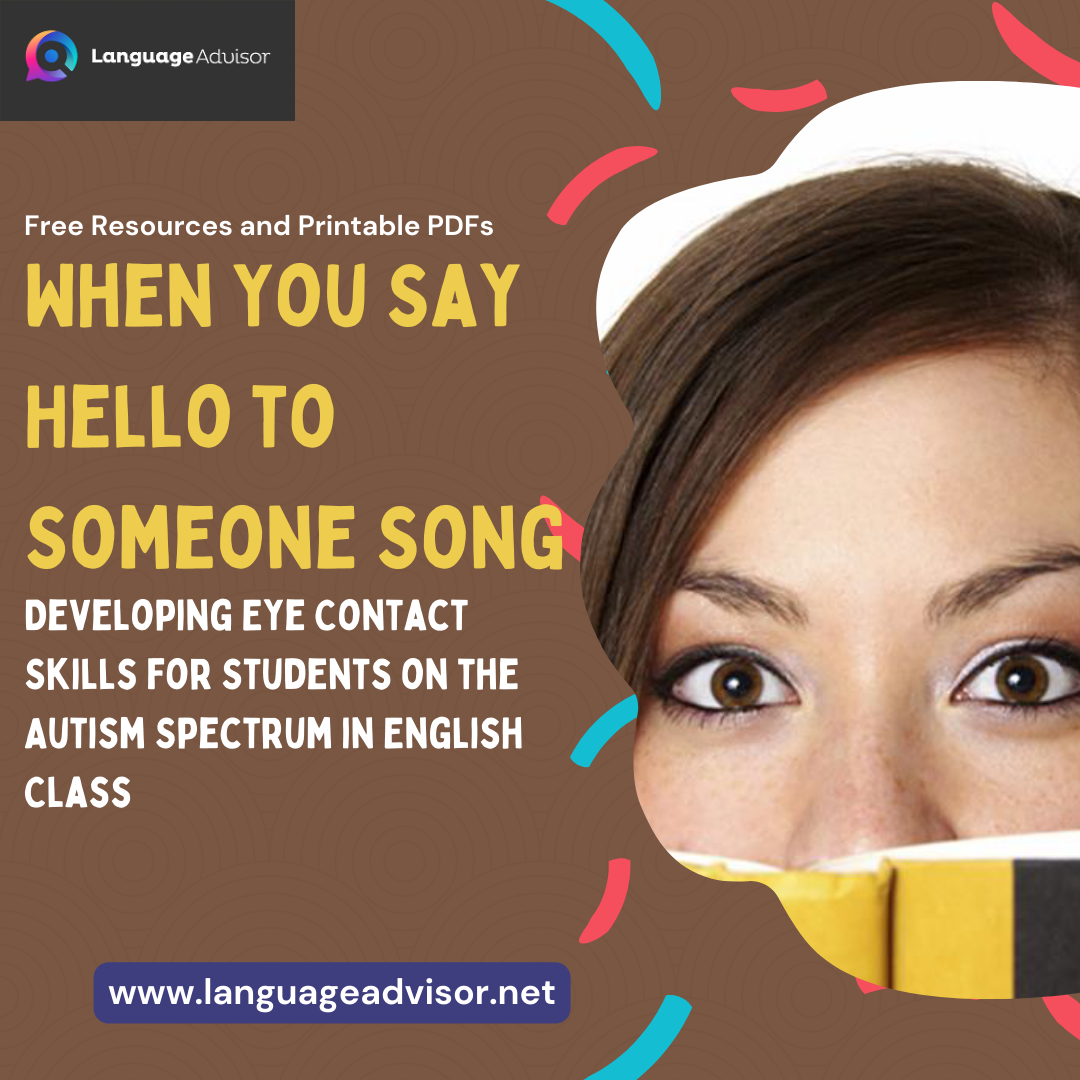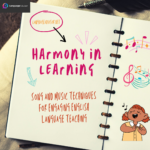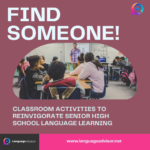When You Say Hello to Someone Song – Developing Eye Contact Skills for Students on the Autism Spectrum in English Class: Free Resources and Printable PDFs
When You Say Hello to Someone Song – Developing Eye Contact Skills for Students on the Autism Spectrum in English Class

For students on the autism spectrum, making eye contact can be a challenging social skill, but with patience and the right strategies, it can be developed in a way that feels comfortable and supportive. Eye contact plays an important role in communication, signaling attention, understanding, and engagement. In English class, a structured environment where students engage in discussions, presentations, and collaborative work, there are many opportunities to practice making and understanding eye contact.
In this blog post, we’ll explore how to help students on the autism spectrum improve their eye contact skills in a safe and supportive manner. We also offer free printable PDFs with activities and tips designed to make learning eye contact easier and more approachable for students.
Why Eye Contact is Important
While making eye contact is often a natural part of social interaction for neurotypical individuals, for students on the autism spectrum, it can feel overwhelming or uncomfortable. However, encouraging students to practice eye contact—at their own pace—can help them:
- Engage better in conversations by showing they are listening and interested.
- Improve communication by understanding the role of eye contact in expressing emotions and attention.
- Build relationships by fostering more effective social interactions with peers and teachers.
It’s important to approach this skill with sensitivity, understanding that every student is different and some may find eye contact more challenging than others.
Key Eye Contact Skills to Develop
When helping students on the autism spectrum develop eye contact skills, it’s useful to focus on specific areas, including:
- Understanding when to make eye contact: Helping students recognize the right moments to look at someone’s face during a conversation, such as when they are listening or responding.
- Maintaining comfortable eye contact: Learning to make brief, manageable eye contact without feeling pressure to stare.
- Reading facial expressions: Teaching students to pair eye contact with interpreting facial cues, which can improve their overall communication.
Free Printable PDF Resources
We’ve created several free printable PDFs that can help students practice making eye contact in a way that is gradual and stress-free. These resources are adaptable for different age groups and can be used both in the classroom and at home.
1. Eye Contact Social Stories
Social stories are an effective way to help students understand specific social situations, including when and why eye contact is important. These stories explain situations like:
- How to make brief eye contact when someone is speaking.
- How to look at a person’s face when saying “hello” or “thank you.”
- What to do if making eye contact feels uncomfortable (such as focusing on the person’s nose or mouth instead).
By providing clear examples, social stories can reduce anxiety and help students feel more confident when practicing eye contact.
2. Gradual Eye Contact Practice Worksheets
For students who find eye contact challenging, gradual exposure is key. Our worksheets offer exercises that allow students to practice eye contact in small steps, including:
- Looking at pictures of faces and making eye contact with them for a few seconds.
- Practicing eye contact with a partner for short intervals, gradually increasing the time.
- Learning to balance eye contact with looking away when they need a break.
These worksheets allow students to build eye contact skills at a comfortable pace.
3. Facial Expression Matching
Eye contact often helps people understand emotions. Our facial expression worksheets help students on the autism spectrum recognize and interpret different expressions while practicing making eye contact. These printable resources include:
- Matching faces with emotions like happy, sad, angry, or surprised.
- Practicing looking at a person’s eyes to understand their feelings.
- Discussing what facial expressions mean and how they relate to the conversation.
These exercises combine eye contact practice with emotional understanding, strengthening overall social skills.
4. Role-Playing with Eye Contact
Role-playing can make practicing eye contact more fun and interactive. Our PDF includes role-playing scenarios where students can practice eye contact in conversations, such as:
- Greeting a classmate or teacher with eye contact.
- Asking and answering questions while briefly looking into the other person’s eyes.
- Working in pairs to discuss a topic while practicing maintaining comfortable eye contact.
These activities help make the skill more natural and comfortable over time.
How to Use These Resources
Our free printable PDFs are designed to be easy to use and can fit into your existing lesson plans. Here’s how to integrate them into your English class:
- Warm-Up Exercises: Use the eye contact social stories or gradual practice worksheets as warm-up activities before starting the lesson.
- One-on-One Practice: For students who need more individualized support, use the facial expression worksheets or role-playing activities to focus on eye contact in a small group or one-on-one setting.
- Group Activities: Incorporate role-playing exercises during group discussions or collaborative work, allowing students to practice eye contact in a supportive and safe environment.
When You Say Hello to Someone Song – Conclusion
Helping students on the autism spectrum develop the ability to make eye contact is an important step in improving their communication and social interaction skills. By breaking the process down into manageable steps and offering plenty of positive reinforcement, students can gradually become more comfortable with eye contact.
We hope that these free printable PDFs provide valuable tools to support students on the autism spectrum in developing this skill. Download these resources today and create a more inclusive and supportive classroom where every student feels empowered to connect and communicate.
With these resources, you can help students on the autism spectrum practice making eye contact in a stress-free, enjoyable way, fostering better social interactions and helping them succeed both in and out of the classroom. Happy teaching!

When You Say Hello to Someone Song
To the tune of “If You’re Happy and You Know It.”


When You Say Hello to Someone Song – Advanced
DOWNLOAD THE PDF FOR FREE

When You Say Hello to Someone Song – Easy





